ThinkPad Tablet - business class tablet
 This year, Lenovo introduced three Android-based tablets at once - two in the IdeaPad series (K1 on Nvidia Tegra and the budgetary single-core A1), and one in the ThinkPad series, simply called ThinkPad Tablet. Just recently, a business tablet went on sale in Russia, and I became one of its first owners. Unlike a laptop, which has a number of specified and easily measured characteristics, the tablet is a device for personal use, about which a set of benchmarks will not say anything. Therefore, I did not take a test copy, and realized a long-standing desire to become the owner of a compact device with a touch screen. In this material - a detailed review of the device, but I can immediately say that I did not regret about the purchase. This is one of the most advanced devices for iron, with a really useful set of additional programs "out of the box" and, finally, with a very thoughtful set of branded accessories.
This year, Lenovo introduced three Android-based tablets at once - two in the IdeaPad series (K1 on Nvidia Tegra and the budgetary single-core A1), and one in the ThinkPad series, simply called ThinkPad Tablet. Just recently, a business tablet went on sale in Russia, and I became one of its first owners. Unlike a laptop, which has a number of specified and easily measured characteristics, the tablet is a device for personal use, about which a set of benchmarks will not say anything. Therefore, I did not take a test copy, and realized a long-standing desire to become the owner of a compact device with a touch screen. In this material - a detailed review of the device, but I can immediately say that I did not regret about the purchase. This is one of the most advanced devices for iron, with a really useful set of additional programs "out of the box" and, finally, with a very thoughtful set of branded accessories.
Specifications
Processor : Nvidia Tegra 2, dual core, 1 GHz
RAM : 1 GB
Storage : 16, 32 or 64 GB
Screen : 10.1 inches, IPS, 1280x800 dots, touch MultiTouch + N-Trig (for working with a pen, sensitive to pressing force)
Wireless networks : WiFi 802.11n, Bluetooth 3.0, 3G (optional), GPS
Connectors : 1xUSB 2.0, headset, docking station, microUSB (charging and PC connection), MiniHDMI, full-size SD / SDHC card slot
Camera : 5 megapixels (main), 2 megapixels (front)
In addition : 4 hardware keys ("home", "back", "web", screen rotation lock), a slot for the stylus.
Battery : 2cell, up to 10 hours battery life
Dimensions : 260x181x14,5 mm
Weight : 740 g
Optional accessories : a simple leather case, a case with a keyboard and an optical trackpoint, a fast charging docking station
')
Appearance
What can I say, Lenovo designers were able to make the device in strict accordance with the ideology and values of the ThinkPad series. The tablet turned out to be black, square, reliable, durable and prim. In a sense, this is the opposite of Apple's models, or, say, Samsung, but in the ThinkPad series, this tablet looks very organic. The device turned out a little thicker and wider than the main competitors, but I see more than a minus in this rather than a minus. Tablet is very catchy, you can hold it tightly without fear of accidentally pressing a button or on the screen. As for weight, everything is within reason, the tablet may be a bit heavier than its “passport” analogs, but personally I don’t notice much of a difference.
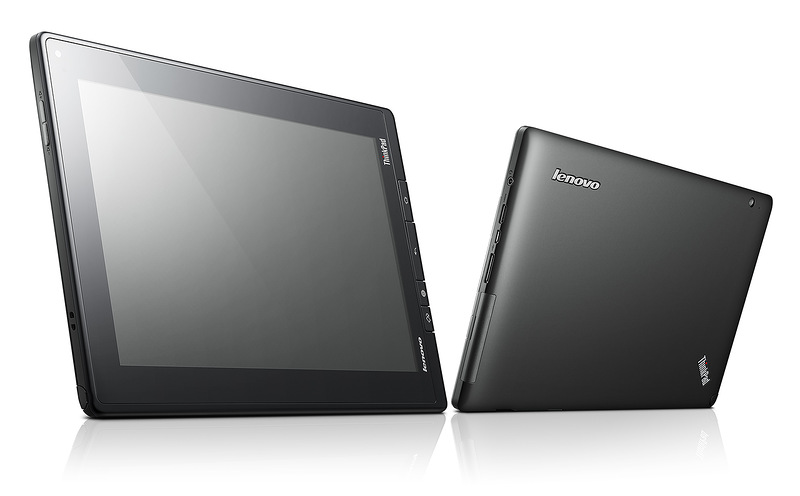
The back cover is made of thick plastic, similar to that used in ThinkPad notebooks, with a slightly rough surface. Here is the ThinkPad logo with a red LED instead of a dot above i. The whole construction was very durable - no backlash or squeaks. At the same time, the tablet, judging by the service manual available on the website, is quite easily disassembled.
The entire front panel is covered with Gorilla Glass, which is integrated into the case without dust-collecting gaps. And yes, the glass is glossy. For myself, I have so far decided this issue by buying and pasting a matte film, although I may get rid of it in the future - the glossy surface collects glare, but the display brightness (400 nits) allows you to read the text comfortably even in bright light.

The hardware buttons under the screen are a trick that I appreciated right away. The "back" and "home" keys are much more convenient to use, despite the fact that in Android Honeycomb, similar virtual buttons are always available at the bottom of the screen. In this case, the keys are made so that it is impossible to click on them accidentally. Hopefully, over time, it will be possible to reassign keys to other functions.
Connectors
The main set of connectors assembled on the bottom edge. There is a company port here, but it is used only for an optional docking station (more about it later). The standard microUSB connector is designed to connect to a PC or to charge from a complete dual-amp power supply. An important difference from other models is the possibility of charging from a computer: this is not a fast method, since only 0.5A will be supplied from the PC instead of the required two, but still working - checked. MiniHDMI port allows you to connect the tablet to the TV. There is also a headphone or headset jack. Under a separate cover there are slots for a SIM card, a full-size SD card and a reset button, which allows you to exit to the recovery menu.

A full-size memory card slot allows, firstly, saving on the expansion of data storage space - such cards are cheaper than a microSD of the same size. Secondly, there is an undocumented, but a real opportunity to add not 32 but 64 gigabytes of memory by purchasing an SDXC card. This format is not officially supported, but I still decided to try. It turned out, everything is quite simple. SDXC cards are formatted in the default format exFAT, which the tablet does not understand. Windows allows you to format such a card only in exFAT or NTFS (the latter, alas, is also not supported yet). But in Ubuntu Linux I was able to format the card in FAT32, after which the Tablet recognized it without any problems. I used the Transcend Class 10 card, and I cannot give guarantees that other SDXC cards will also work. However, instead of the standard 64 gigabytes of storage, I now have almost 128.
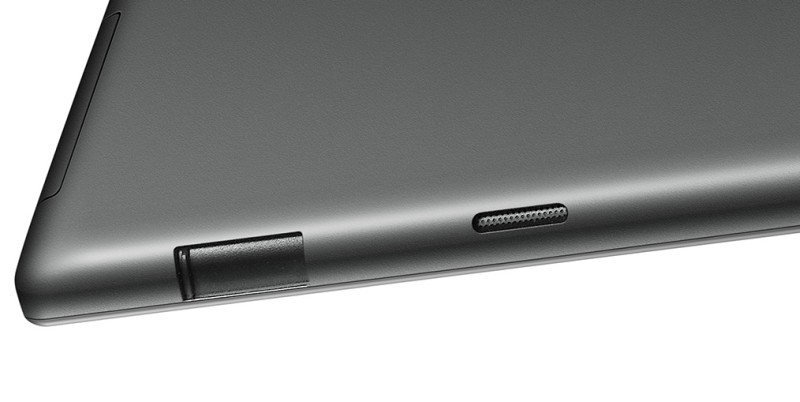
A full-sized USB port is hidden on the side edge under a special curtain. I easily connected a keyboard, flash drives and even hard drives to it. An optional accessory is connected to it - the same case with a keyboard and trepoint. Also at the end of the grid is a single speaker. It provides sound volume comparable to competitors, but films are sometimes not enough. But the audio track based on the Wolfson sound chip provides surprisingly high-quality sound in headphones.
Impressions
Currently, the ThinkPad Tablet is available at a price ranging from 22 (32 GB WiFi) to 38 thousand rubles (64 GB WiFi + 3G + a full set of accessories). For about 30 thousand, you can purchase an intermediate version with 32 gigabytes of memory, a 3G module and a cover with a keyboard. I purchased the most “clever” kit with a full set of accessories (docking station, case with keyboard, branded headphones). Naturally, most of the time the tablet is used for the consumption of content - reading letters, RSS, books, browsing websites, videos or photos. Google’s regular software suite does a good job of it, except for the video I installed a third-party DicePlayer that supports hardware acceleration, MKV format and subtitles. The only “tweak” that I thought was necessary is the translation of flash content into “on demand” mode to speed up the scrolling of web pages.
Naturally, I set up mail and transferred applications acquired and used on a smartphone to my device. The regular mail client and Google Reader allow you to assess how convenient applications that are optimized for a large screen can be, but alas, not all developers are in a hurry to release updates. Fortunately, in compatibility mode, almost all programs work normally, in my case, for example, an excellent omnivorous PowerAMP player, applications for Facebook and Twitter networks, toys (Cut The Rope), a Last.fm client, and much more.
Programs from the set of additional software installed by Lenovo are also very useful. First of all, I’ll note the full version of Documents To Go, in which this text is now typed, a simple and convenient application for sending SMS via the built-in cellular module, a pair of toys (Angry Birds + Solitaire), a basic file manager. The Social Touch application is an aggregator of all events in various social networks, mail and RSS, it looks good, but it didn’t work for me. The appearance of Android Honeycomb is left almost unchanged; only a block of shortcut buttons in the center of one of the desktops has been added. In addition to the standard keyboard, an alternative FlexT9 has been added, with its own implementation of Swype and the possibility of predictive typing.
Pen input
On the complete stylus should talk separately, yet - this is the most unusual feature of the ThinkPad Tablet. In short, a pen input method was implemented in the Lenovo tablet that was completely analogous to that used in ThinkPad X-series Windows-based tablets. The bundled stylus is present in all models except the cheapest (16 GB WiFi) and allows you to take notes with or without handwriting recognition, draw or simply control the tablet with high accuracy. The pen itself looks like this:

It works on AAAA batteries and provides very high accuracy. For notes, a full-featured Notes Mobile program is provided, which supports handwriting recognition, including Russian. Recognition works as a whole not bad, but a lot depends on your handwriting and mistakes, alas, are inevitable. It was not the recognition that was interesting to me, but the storage of handwritten notes in electronic form.

My work involves frequent meetings, which I used to take with me a notebook, a sheet of paper, or just take notes on what came to hand. I tried to take a laptop with me, but it looked strange, and I didn't want to knock on the keys during an important conversation. To solve this problem, I downloaded the application WritePad, which is more convenient to use than Notes Mobile, and most importantly - allowing you to disable finger control altogether - only the pen is accepted. In general, the ThinkPad Tablet is trained to ignore touch when using a stylus, but Notes Mobile has other benefits, such as exporting notes to PDF (or just sending notepad pages that are saved in a regular PNG).
Accessories
As I said at the very beginning, simultaneously with the release of the tablet, Lenovo has prepared a very thoughtful set of accessories. Let's start with a simple leather case:
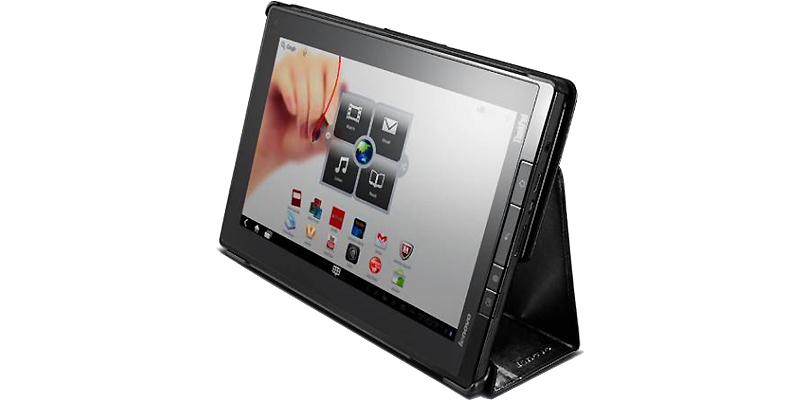
It can already be purchased in Russian stores (look in the price lists under code 0A36370), at a price of about 1,800 rubles. The tablet is installed in a plastic cradle inside the case, which provides additional protection. If desired, the cover becomes a stand, as in the photo, or in a horizontal position.
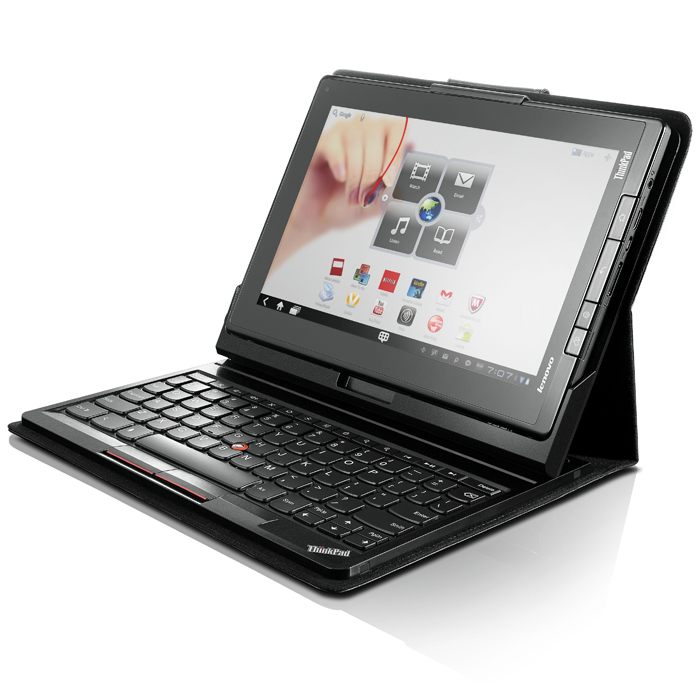
Much more interesting is the case with a built-in keyboard. It consists of two halves, one of which, along the guides, inserts the tablet and connects to the keyboard using the USB port.
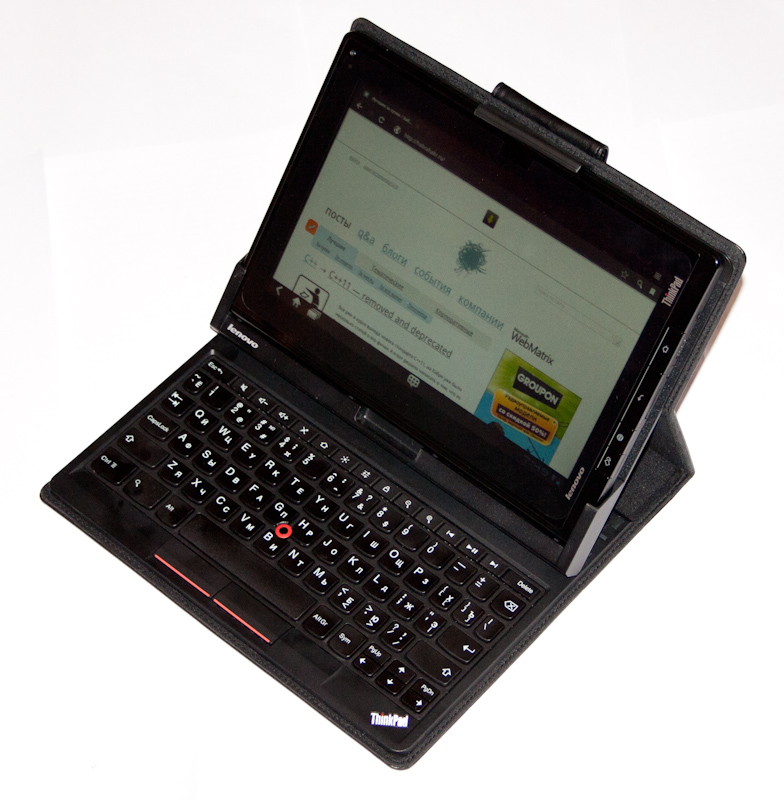
The halves do not have a rigid connection with each other, and the tablet itself is installed on the keyboard in one of three recesses and is held there by magnets. On the one hand, this design provides maximum compactness: a tablet with a keyboard easily fits on the table of an airplane seat. On the other hand, the lack of a hard connection does not allow comfortable work when the tablet is on its knees. That is, this option - rather desktop.
Paying for a set of tablet and cover with a keyboard you get the opportunity to quickly and comfortably typing texts while traveling. The keyboard layout is almost completely consistent with that in ThinkPad Edge laptops, but instead of function keys, there are buttons for quickly accessing functions in Android — volume control, switching to the home screen, settings, and so on.

Of course, the creators of the ThinkPad Tablet could not help but provide the keyboard with a trackpoint. The truth here trackpoint is not mechanical, but optical. In most programs for Android, it is not needed - it is easier to poke in the right place on the screen, but when connected to a remote Windows machine via RDP, it provides the same ease of control as when working on a regular laptop.

Finally, another important accessory is a fast charging docking station. At first I was not very impressed with this device, although it was included in the kit. But it has an important feature: this docking station is connected to the network using a 65-watt laptop charger, the same as the ThinkPad X-series. A powerful power supply ensures the fastest possible charging of the device: from 20 to 100% in just an hour and a half, and you can continue to work on the tablet. The docking station has connectors for headphones and a microphone, as well as another full-sized USB port for external devices.
Autonomous work
Specified in the specifications of 10 hours of battery life ThinkPad Tablet provides, if you browse the web or read a book with WiFi connected. In other situations, battery life may be lower. For example, if you type text on an external keyboard, with 3G connected and activated synchronization with mail, Google Talk and IM +, the tablet will work for about 8 hours. I did the same with 3G turned off and watching a video. If I run the rocking chair of the torrents in the background (I didn’t work out with the Rutracker Downloader, but aDownloader went off with a bang), then six hours will be released. In general, even with active use until the end of the day, the tablet will reach in any case, and if necessary, the battery charge can be stretched to a whole transatlantic flight. Not a record, but quite at the level of competitors.
findings
ThinkPad Tablet is one of the most functional devices on the market, which provides incredible freedom of action, connectivity and allows you to carry with you a huge amount of data. The complete keyboard provides quick typing on the go, and the pen provides the ability to make handwritten notes and annotations to documents. For me, as the owner of such a device, it’s important that Lenovo provide tablet support for as long as possible. Since the model is designed for business and corporate customers, and judging by how Lenovo accompanies ThinkPad notebooks, there is no doubt about that.

Moreover, although there is no official confirmation yet, there is information that the Tablet will still support Android 4.0. In the near future should update the current firmware. The device has just entered the market, but in a short time, I am sure, all additional features will appear for it that Habr's users like: root access, custom firmware, the ability to install Linux, etc. At least in the voting on the XDA-Developers website, the ThinkPad tablet takes the first place for the right to create a separate section and, accordingly, to attract the attention of fans to squeeze the maximum opportunities out of devices.
Those who need a device with a high-quality screen, decent battery life and fast iron can now pay attention to the most unusual tablet on the market. Lenovo branded stores ( www.ideapad.ru ) already have demo copies, so you can check it out for yourself. There are also available basic versions of the tablet, and all the rest - under the order.
There is little information about the ThinkPad Tablet in Russian. Therefore, I am ready to answer any of your questions about this device in the comments.
Source: https://habr.com/ru/post/131741/
All Articles